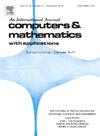Effective nonlocal finite element formulation for free vibration analysis of S-FGM doubly curved nanoshells based on linear strain–displacement relations using TSDT
IF 2.5
2区 数学
Q1 MATHEMATICS, APPLIED
引用次数: 0
Abstract
This paper presents an effective nonlocal finite element method (FEM) for investigating the free vibration behavior of sigmoid functionally graded material (S-FGM) nanoshells using nonlocal elasticity theory. The effective nonlocal parameters via third-order shear deformation theory (TSDT) are varied along the thickness of the nanoshells following the sigmoid function. In this study, two different sigmoid functions FGM (S1-FGM and S2-FGM) are considered for the ceramic volume fraction. For S1-FGM, the top and bottom surfaces are ceramic and metal, respectively, whereas the middle surface has the average properties of its constituent materials. In order to increase the stiffness of S1-FGM, ceramic and metal are used at the bottom and midplane surfaces, respectively, to form S2-FGM, which is used to investigate and compare with S1-FGM. The governing equation of the S-FGM nanoshells is formulated based on Hamilton's principle. The numerical results are obtained by finite element method (FEM) with a nine-node quadrilateral (Q9) Lagrangian element and are in close agreement with the published results. The numerical investigation indicates that the frequency parameter decreases with increasing nonlocal parameters. The frequency parameters of S1-FGM nanoshells decrease slowly when the sigmoid material index increases, whereas the frequency parameters of the S2-FGM shells increase quickly (0 ≤ n ≤ 1). then slowly as the sigmoid material index increases. Finally, the effects of the geometrical parameters of the S-FGM nanoshells accounting for the effective nonlocal parameters on the non-dimensional frequency parameter are investigated.
基于线性应变-位移关系的S-FGM双弯曲纳米壳自由振动分析的有效非局部有限元公式
本文提出了一种有效的非局部有限元法(FEM),利用非局部弹性理论研究了西格码功能分级材料(S-FGM)纳米壳的自由振动行为。通过三阶剪切变形理论(TSDT),有效的非局部参数沿纳米壳的厚度变化,并遵循 sigmoid 函数。在本研究中,针对陶瓷体积分数考虑了两种不同的 sigmoid 函数 FGM(S1-FGM 和 S2-FGM)。对于 S1-FGM,顶部和底部表面分别为陶瓷和金属,而中间表面则具有其组成材料的平均特性。为了增加 S1-FGM 的刚度,在底面和中面分别使用陶瓷和金属,形成 S2-FGM,用于研究和比较 S1-FGM。根据汉密尔顿原理建立了 S-FGM 纳米壳的控制方程。数值结果是用有限元法(FEM)和九节点四边形(Q9)拉格朗日元素得到的,与已发表的结果接近一致。数值研究表明,频率参数随非局部参数的增加而降低。S1-FGM纳米壳的频率参数随着西格玛材料指数的增大而缓慢减小,而S2-FGM纳米壳的频率参数则随着西格玛材料指数的增大而迅速增大(0 ≤ n ≤ 1),然后缓慢减小。最后,研究了 S-FGM 纳米壳的几何参数(考虑到有效非局部参数)对非维频率参数的影响。
本文章由计算机程序翻译,如有差异,请以英文原文为准。
求助全文
约1分钟内获得全文
求助全文
来源期刊

Computers & Mathematics with Applications
工程技术-计算机:跨学科应用
CiteScore
5.10
自引率
10.30%
发文量
396
审稿时长
9.9 weeks
期刊介绍:
Computers & Mathematics with Applications provides a medium of exchange for those engaged in fields contributing to building successful simulations for science and engineering using Partial Differential Equations (PDEs).
 求助内容:
求助内容: 应助结果提醒方式:
应助结果提醒方式:


